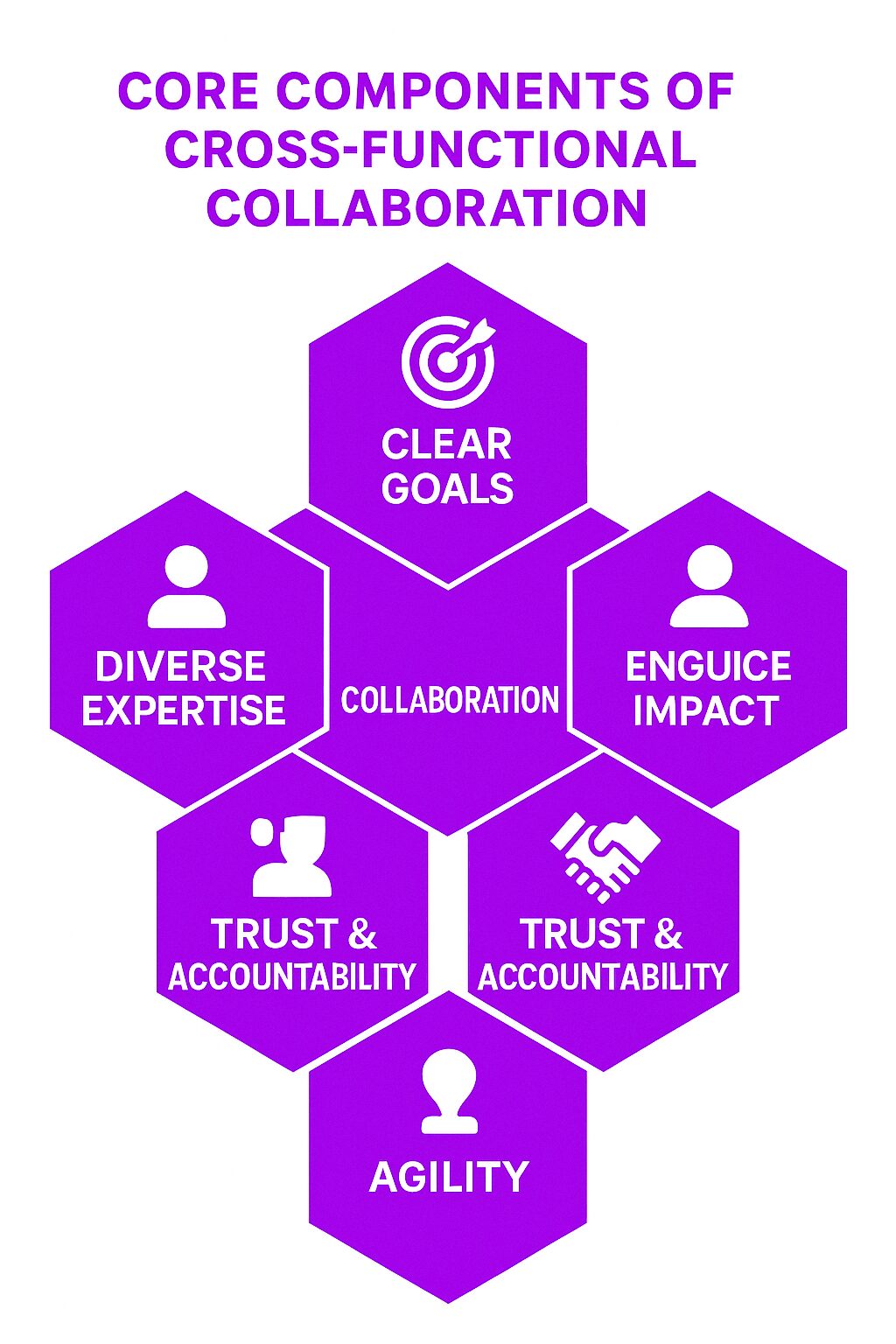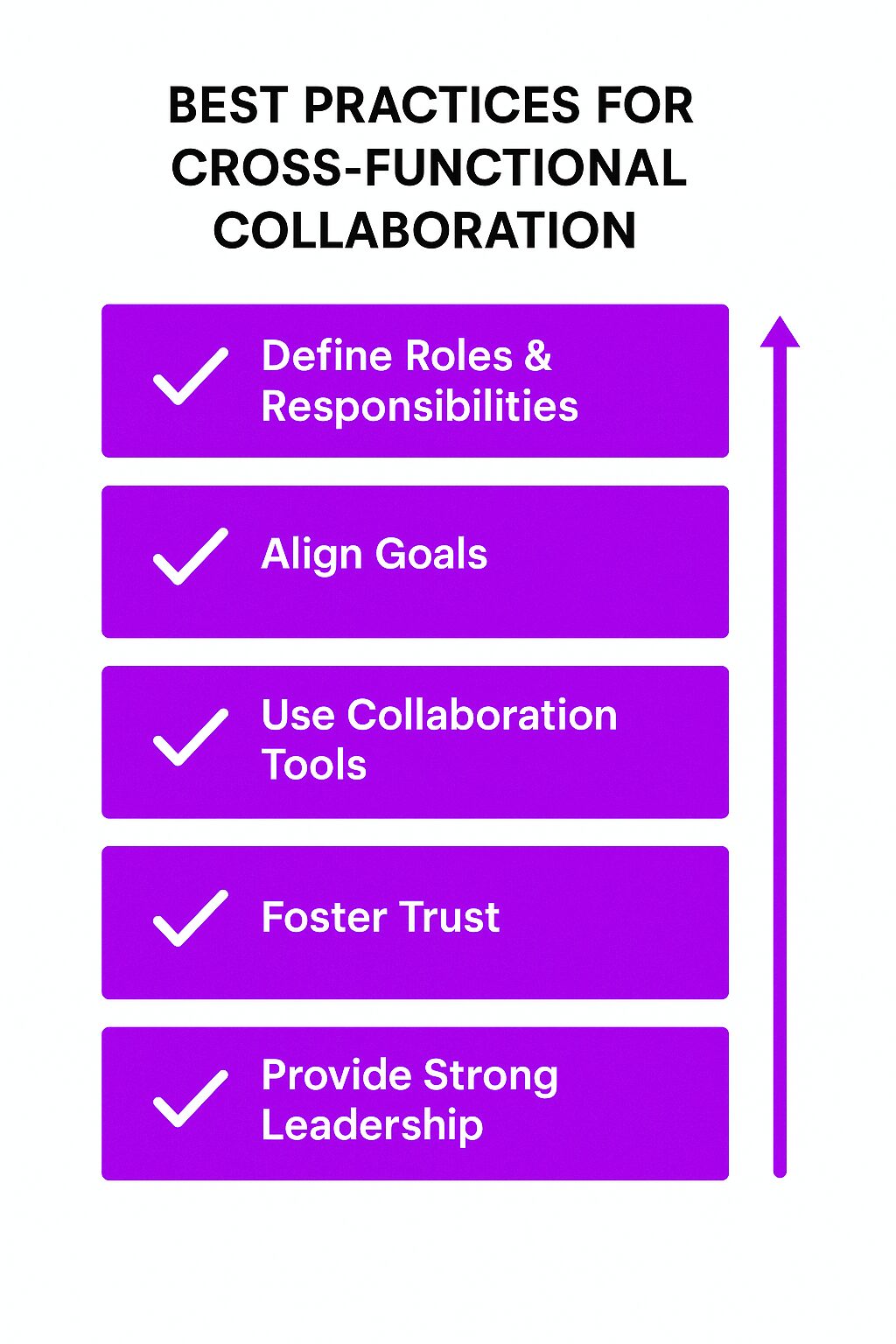What Is Cross-Functional Collaboration?
Cross-functional collaboration is the practice of bringing together individuals from different departments or areas of expertise to work toward a shared goal. Unlike traditional teams that operate within specific functions like marketing, sales, or engineering, cross-functional teams integrate multiple skill sets to solve problems, drive innovation, and improve organizational outcomes.
Organizations that embrace cross-functional collaboration break down silos and create a culture of cooperation. Cross functional collaboration occurs between various internal departments, allowing for a diverse range of expertise and perspectives. This approach allows for diverse perspectives, more informed decision-making, and faster problem-solving. It is widely used in project management, product development, and strategic initiatives that require input from various business functions.
How Cross-Functional Collaboration Works
Cross-functional teams are designed to leverage the strengths of different departments. Starting with small cross-functional projects can build trust among team members and facilitate collaboration. These teams are typically structured around specific projects or objectives, such as launching a new product, improving customer service processes, or streamlining internal workflows.
Successful collaboration depends on clear communication, defined roles, and shared accountability. Teams must establish expectations early, use common tools for coordination, and continuously align their efforts to organizational goals. Without these elements, cross-functional collaboration can become disorganized and counterproductive.
Key Components of Cross-Functional Collaboration
1. Clear Goals and Shared Vision
Cross-functional teams must engage in collaboration efforts, leveraging shared knowledge from subject matter experts and the guidance of influential leaders to create effective collaborative environments. Every team member should understand what they are working toward and how their contributions fit into the bigger picture.
2. Diverse Expertise in Cross Functional Teams
Each team member brings a unique perspective and skill set. Working with people from different teams or departments to achieve common goals fosters creativity and leads to well-rounded solutions. A successful cross-functional team might include product managers, engineers, marketers, data analysts, and customer support representatives.
3. Effective Communication
Communication barriers often arise when different departments use different terminology and processes. Utilizing effective project management tools can significantly improve organization, planning, tracking, and overall project success. Establishing common language, using collaboration tools, and maintaining regular updates ensure that all team members remain informed.
4. Trust and Accountability
Trust is essential for effective collaboration. Team members must respect each other’s expertise and be willing to share ideas openly. Additionally, clear accountability structures help ensure that each person takes ownership of their responsibilities.
5. Strong Leadership
Team leaders or project managers help coordinate efforts, resolve conflicts, and keep the team focused on its objectives. Team leaders play a crucial role in gaining buy-in and engagement from teams, streamlining processes, and ensuring that collaboration remains productive.
6. Agility and Adaptability
Cross-functional teams must be flexible enough to adjust to new information and evolving business needs. Agility allows teams to pivot when necessary and adopt the best strategies for success.
Purpose and Importance of Cross-Functional Collaboration
Organizations that operate in silos struggle with inefficiency, poor communication, and missed opportunities. Effective cross-functional collaboration leads to improved outputs from multifaceted teams and provides best practices for overcoming challenges associated with implementing successful cross-functional strategies. Cross-functional collaboration helps eliminate these issues by:
-
Encouraging knowledge-sharing across departments.
-
Reducing bottlenecks caused by departmental isolation.
-
Improving problem-solving by incorporating diverse perspectives.
-
Driving innovation through collaborative brainstorming and feedback loops.
-
Enhancing efficiency by streamlining workflows and reducing redundancies.
Companies that prioritize cross-functional collaboration see improved business performance, faster project completion, and stronger alignment between teams.
Benefits of Cross-Functional Collaboration
1. Accelerates Innovation
Cross team collaboration, which emphasizes the importance of diverse team compositions, enhances productivity and helps achieve project goals by combining different skill sets and viewpoints to develop creative solutions that might not emerge in isolated departments. Companies like Apple and Google leverage cross-functional teams to design seamless products that integrate hardware, software, and user experience.
2. Improves Decision-Making
Collaboration brings multiple perspectives to the table, leading to more informed decisions. Having all team members on the same page is crucial for ensuring effective collaboration and successful project outcomes. Teams consider data from different sources, anticipate challenges, and mitigate risks more effectively.
3. Enhances Employee Engagement
Employees feel more valued when they contribute to meaningful projects that extend beyond their immediate roles. This sense of contribution leads to higher engagement and job satisfaction.
4. Reduces Silos and Improves Communication
Departments often operate independently, leading to inefficiencies. Cross-functional collaboration fosters transparency, ensuring that cross-functional teams and other teams work together to leverage diverse perspectives and innovative solutions rather than in competition.
5. Strengthens Customer Experience
By combining insights from the sales team to inform the marketing team, along with input from customer service and product development, companies can create solutions that better address customer needs. This leads to higher customer satisfaction and brand loyalty.
Challenges of Cross-Functional Collaboration
1. Misalignment of Goals
Different departments often have competing priorities. Without a shared vision, collaboration can become disjointed and unproductive.
2. Communication Barriers
Each department may use different terminology, tools, and workflows. When managing remote teams, it is crucial to emphasize effective communication and collaboration strategies to ensure smooth operations. Miscommunication can lead to delays, confusion, and frustration.
3. Power Struggles
Disagreements over decision-making authority can create tension. Without clear leadership, cross-functional teams risk stalling progress.
4. Resistance to Change
Employees may be hesitant to adopt new processes or work outside their comfort zones. Overcoming resistance requires leadership support and clear incentives.
5. Lack of Accountability
If roles and responsibilities are unclear, tasks may be duplicated, neglected, or completed inconsistently. A structured approach ensures accountability and follow-through.
Best Practices for Cross-Functional Collaboration
1. Establish Clear Communication Guidelines
-
Use collaboration tools like Slack, Microsoft Teams, or Asana to maintain transparency.
-
Schedule regular check-ins to ensure alignment.
-
Encourage open dialogue and feedback to resolve conflicts early.
-
Project managers play a crucial role in facilitating clear communication and collaboration within cross-functional teams, preventing misunderstandings and streamlining workflows.
2. Define Roles and Responsibilities
-
Assign clear ownership of tasks and deliverables.
-
Ensure that each team member understands their role in achieving the team’s objectives.
3. Align Team Goals with Business Objectives
-
Define measurable success metrics.
-
Ensure that all team members understand how their contributions impact the company’s strategic goals.
4. Foster a Culture of Trust and Respect
-
Encourage knowledge-sharing without fear of criticism.
-
Recognize and celebrate team achievements.
-
Address conflicts constructively and professionally.
5. Leverage Project Management Tools for Collaboration
-
Use shared dashboards and document repositories for easy access to project materials.
-
Implement workflow automation to streamline processes.
6. Provide Leadership and Support
-
Appoint a facilitator or project manager to keep the team on track.
-
Encourage executives to endorse and participate in cross-functional initiatives.
Real-World Examples of Cross-Functional Collaboration
1. Apple’s Product Development
Apple’s ability to deliver seamless user experiences comes from cross-functional collaboration between hardware designers, software engineers, marketers, and customer experience teams. This holistic approach ensures that Apple products function flawlessly across devices and services.
2. Nike’s Sportswear Design
Nike’s design teams work closely with athletes, material scientists, and marketing specialists to develop high-performance sportswear that meets both functional and aesthetic standards.
3. Pixar’s Animation Process
Pixar films result from close collaboration between animators, storytellers, and computer scientists. Cross-functional teamwork allows creative and technical experts to blend artistry with advanced technology.
4. Tesla’s Automotive Innovation
Tesla’s electric vehicles integrate contributions from battery engineers, software developers, and industrial designers. This collaborative model has enabled Tesla to lead the electric vehicle industry.
Final Thoughts
Cross-functional collaboration is essential for organizations that want to foster innovation, improve decision-making, and enhance teamwork. While challenges such as miscommunication and goal misalignment exist, companies that implement clear communication strategies, defined roles, and strong leadership can achieve meaningful collaboration. By breaking down silos and leveraging diverse expertise, businesses create stronger, more agile teams that drive success.







